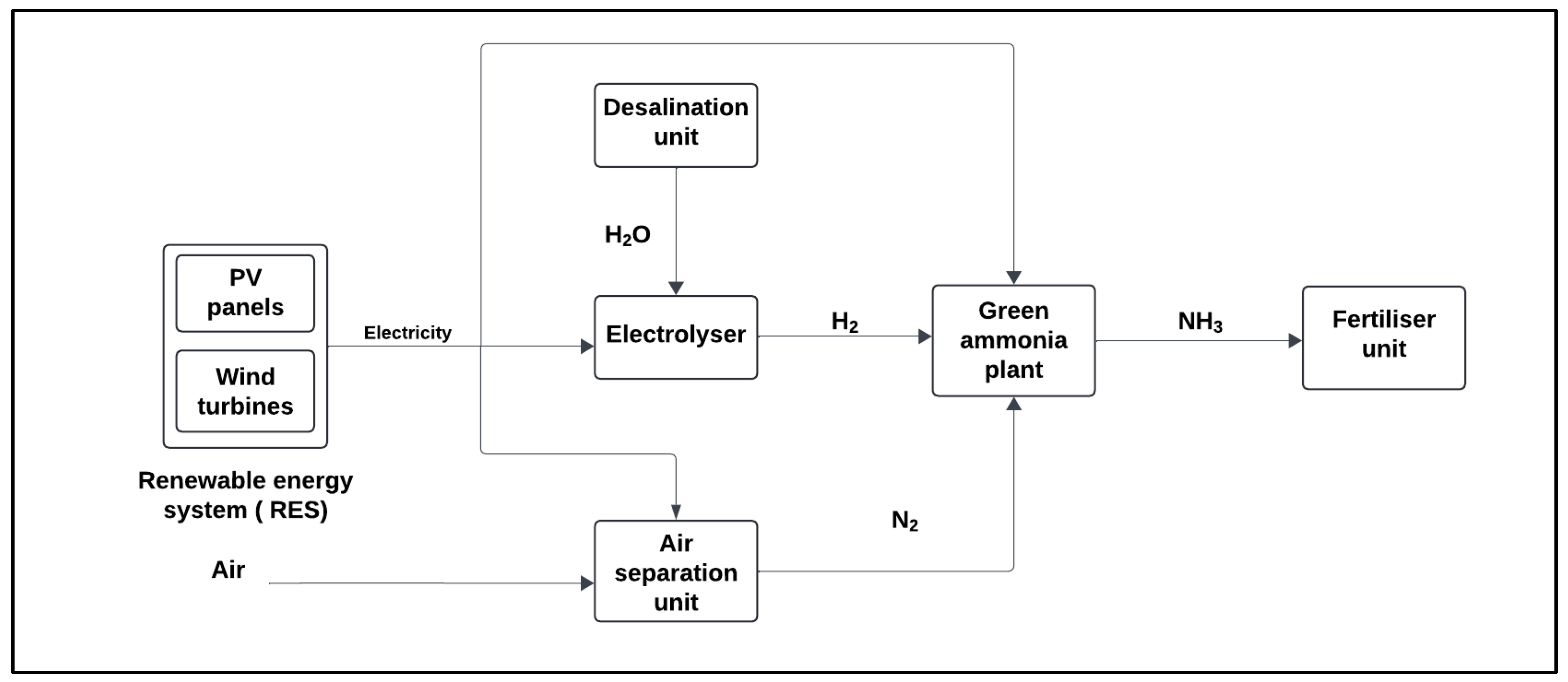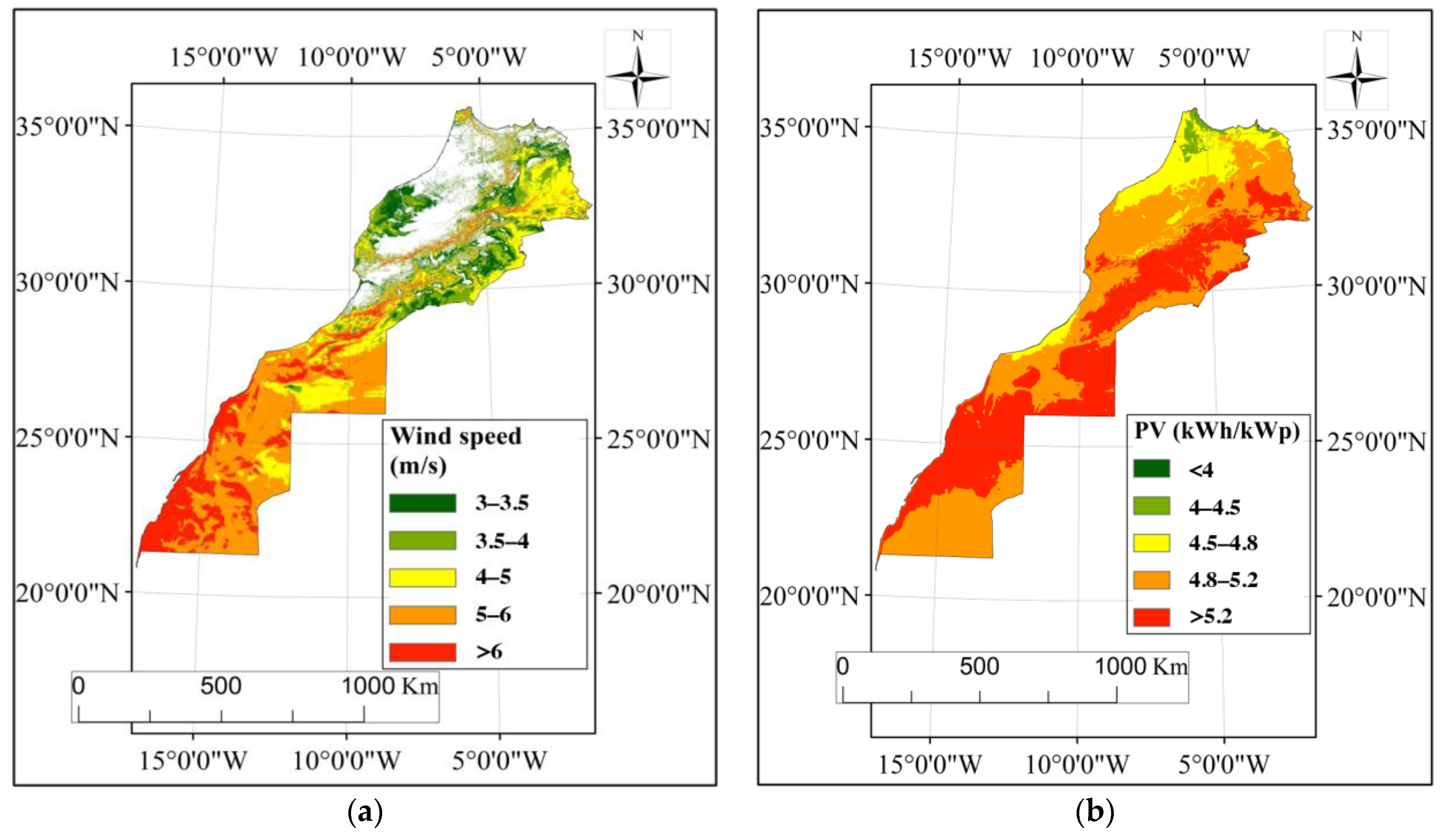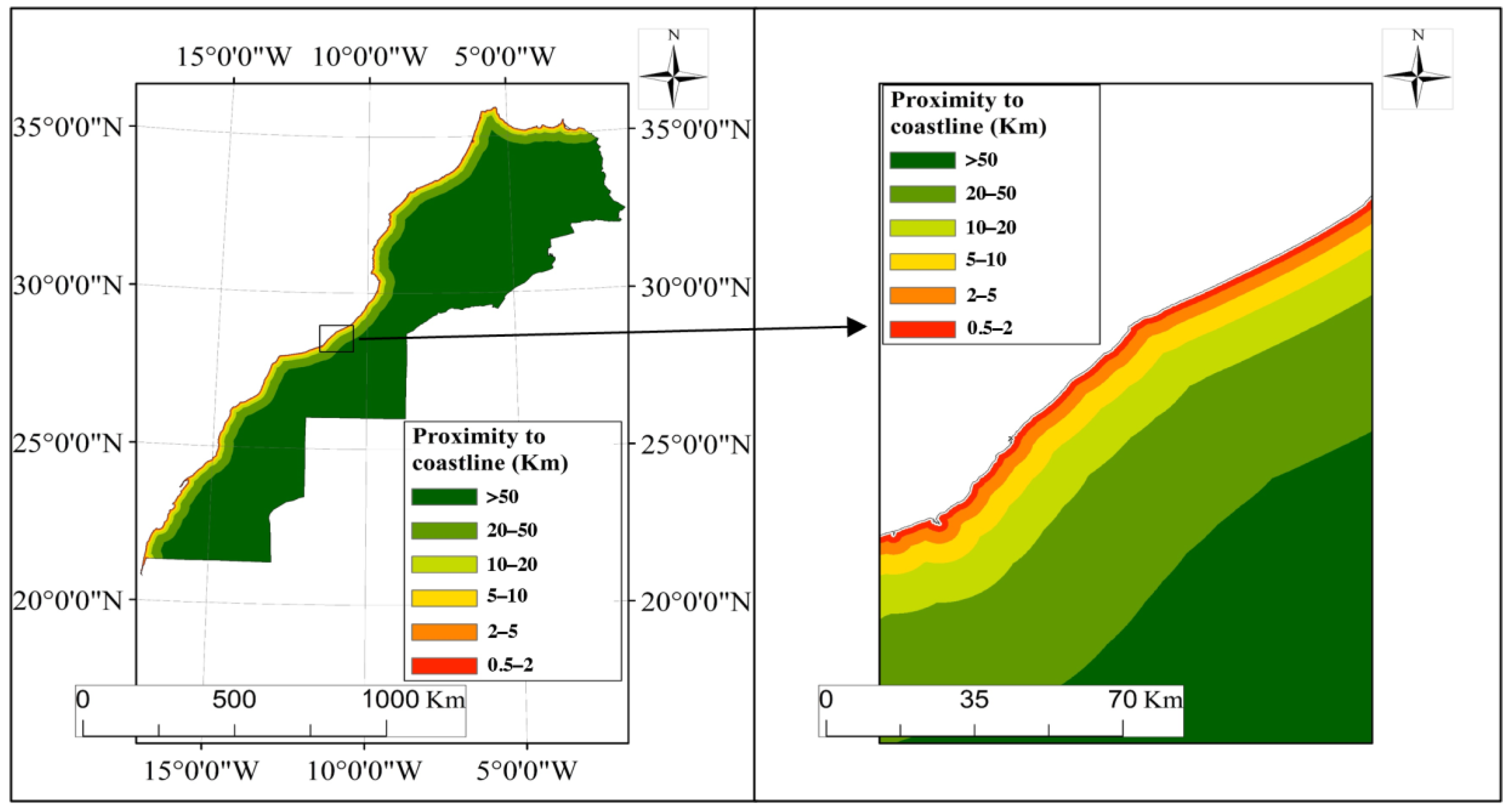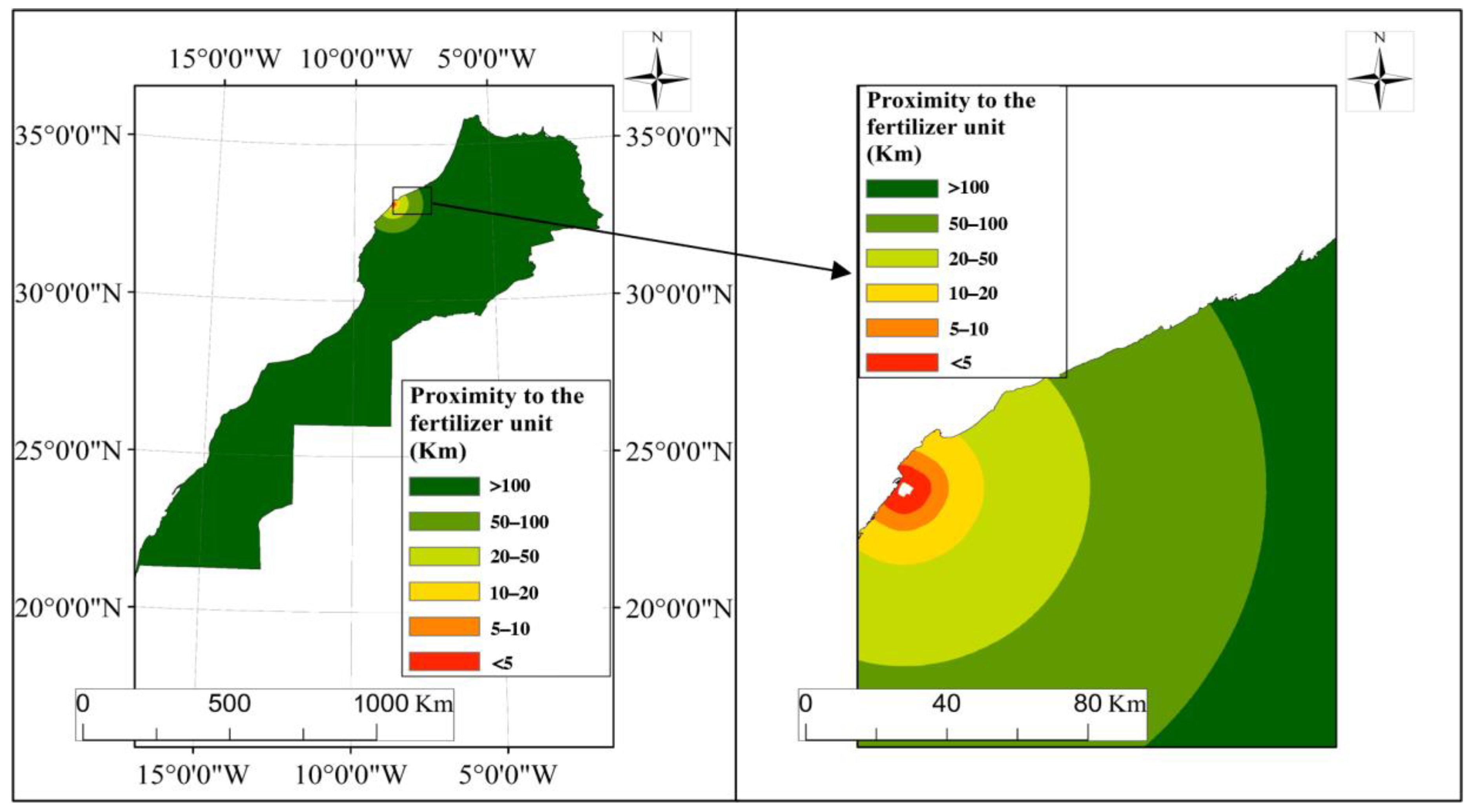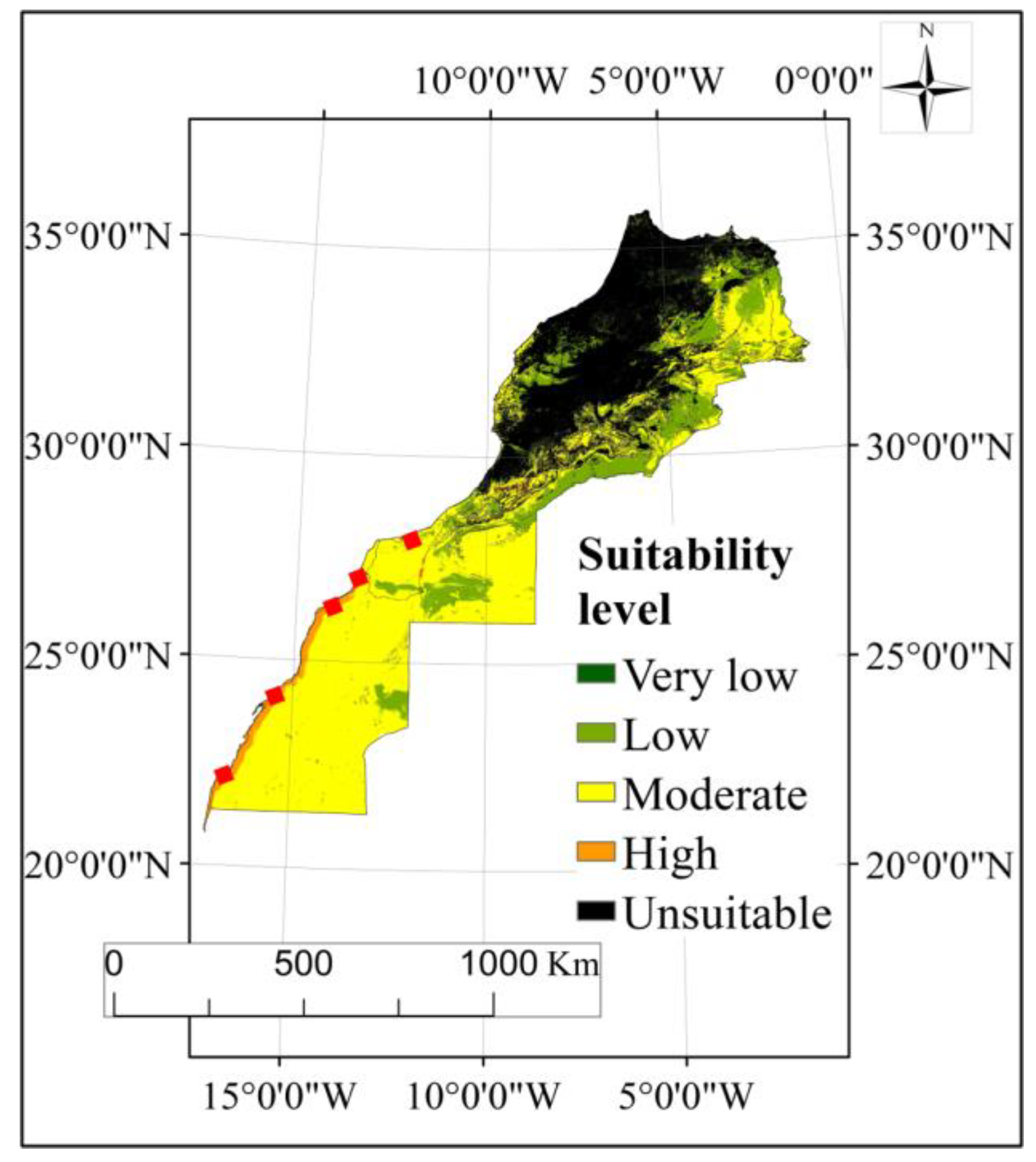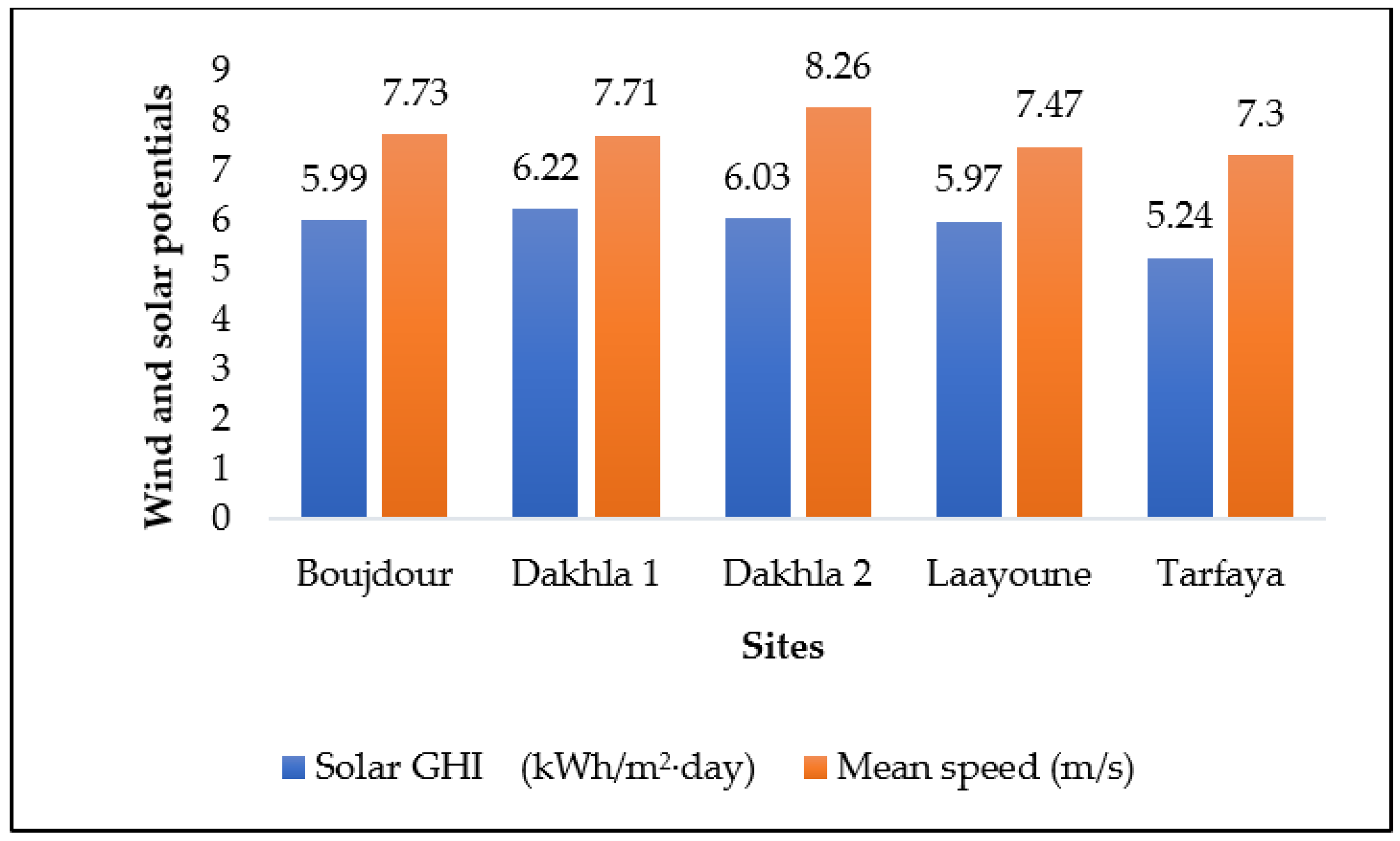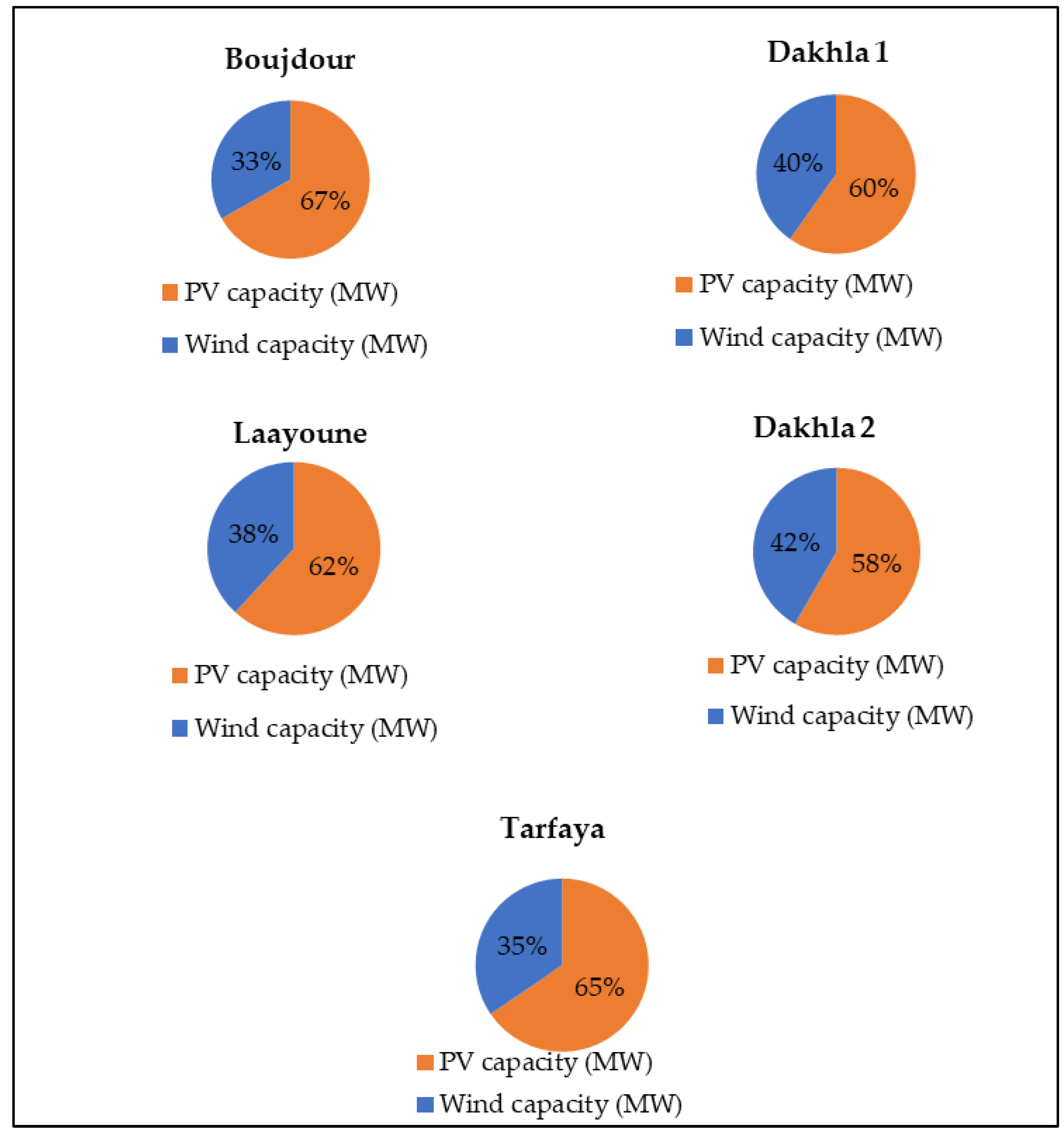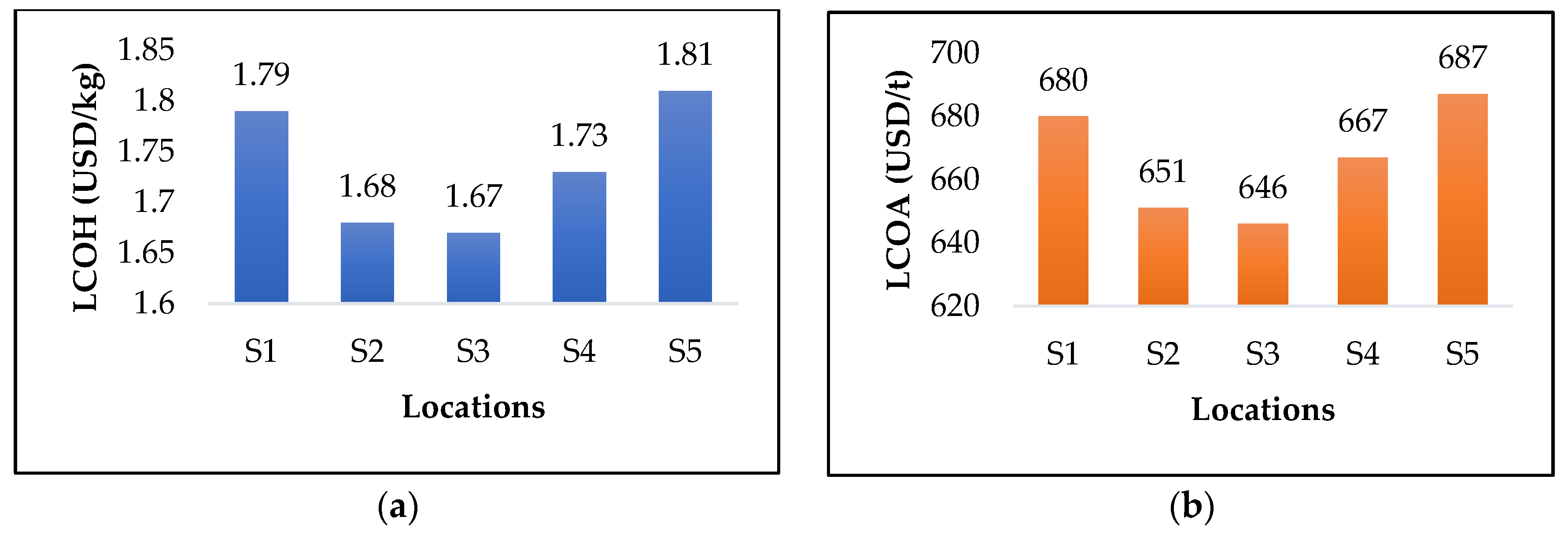1. Introduction
Energy and industrial sectors are responsible for 42% and 26% of CO
2 emissions worldwide, respectively [
1]. Ammonia production accounts for a significant amount of these emissions through the conventional natural gas process. Currently, it accounts for over 11% of worldwide industrial CO
2 emissions and 1.3% of total emissions [
2]. In line with the international commitments to reduce the carbon footprint, decarbonized manufacturing is extremely required. Considering the infrastructure, security, transportation, supply chain, and the anticipated decrease in the costs of green electricity, electrolyzers, and carbon capture methods, ammonia production is increasingly encouraging for use as fuel, in electricity storage, and as a raw material for chemical industries. Ammonia offers several key advantages, as it is six times more compact than hydrogen at a storage pressure of 20 MPa. It can be stored at a high hydrogen density and transported at low pressure, reducing storage and transportation costs. It offers lower storage costs than hydrogen. For example, storing ammonia for 182 days costs approximately 0.54 USD/kg, whereas hydrogen storage costs around 14.95 USD/kg [
3,
4]. Lee et al. [
5] have concluded in their research that ammonia hydrogen storage is the most advisable technology for long-term sustainability. Regarding transport, the cost of transporting ammonia by ship is about USD 6.94 per ton of NH
3, and by pipeline, it is around USD 34.4 per ton of NH
3 [
6,
7,
8]. Therefore, storing and transporting hydrogen as ammonia is extremely convenient and presents a promising solution.
Morocco has the potential to contribute significantly to the green ammonia industry development. It presents one of the greatest phosphate deposits, holding 75% of the world’s phosphate rock reserves. It is the second-largest international phosphate fertilizer producer (40 million tons in 2022 [
9,
10]). However, currently, the use of grey ammonia in the fertilizer industry is still dominant. The national market relies on imported grey ammonia, reaching up to 2 million tons/year [
11,
12]. To reduce this dependence, a paradigm shift is required towards local green ammonia production, not only to strengthen the local manufacturing of fertilizers but also to take part in the international market (green mobility). In this regard, several strategies and initiatives have been implemented to accelerate the transition. “Green Hydrogen Roadmap” targets a total production of 14 TWh by 2030 (10 TWh (71%) for export and 4 TWh (29%) for local use) [
13]. “Morocco Offer” is an operational and incentive offer, where the Government has identified a million hectares of potential land, addressed to investors planning to produce green hydrogen and its derivatives. Regarding projects, the Office Chérifien des Phosphates (OCP) Group is the first company to launch the first pilot green ammonia production project. It is a pre-industrial research and production plant producing 4 tons/day of green ammonia, equipped with an electrolysis capacity of 4 MW and powered by photovoltaic/wind energy [
14]. Moreover, another green ammonia unit is planned near Tarfaya (South of Morocco) with an annual production reaching 200,000 tons/year from 2026. The annual production is increasing to 1 million tons by 2027 and 3 million tons by 2032 [
15].
Morocco presents sufficient resources to go for local ammonia production, either for local use or for export to the international market. The climate gives Morocco great potential in terms of renewable energies available at a competitive cost. It is noteworthy that the levelized cost of electricity (LCOE) for solar power in Morocco ranges between 0.06 and 0.09 USD/kWh [
16,
17,
18]. For wind power, the LCOE reached 0.029 USD/kWh in Morocco according to a recent study carried out by [
19]. Eventually, this will lead to a competitive cost for green hydrogen production. Thus, resulting in lower ammonia production costs. In terms of wind energy potential, the technical onshore wind potential is about 11,500 TWh [
20]. Morocco already reached an installed capacity of 1.43 GW (2022) [
21]. This considerable potential is due to high wind speeds, reaching 11.5 m/s at 80 m [
22,
23]. Regarding solar energy potential, the technical potential for photovoltaics is about 49,000 TWh [
20]. Morocco reached an installed solar energy capacity of about 0.83 GW, including concentrated solar power (CSP), in 2022 [
21]. This considerable potential is due to the high average solar irradiation reaching 5 kWh/m
2·day [
24]. Approximately 79% of Morocco’s total surface area exceeds 2000 kWh/m
2·year in Global Horizontal Irradiation (GHI). These indicate a high suitability for photovoltaics (PV) power plant installation [
25]. Several studies assume that the GHI in suitable areas must exceed 1460 kWh/m
2 [
26,
27,
28]. Others suggest a minimum GHI, ranging from 1000 to 1300 kWh/m
2·year [
29,
30,
31,
32,
33]. In addition to this remarkable potential, the strategic geographical closeness to Europe, existing and future harbors, and gas infrastructure give the country a strong position in the international market as a leading exporter of green ammonia [
34].
Powering a green ammonia unit using renewable sources is a challenging task that requires careful evaluation of several parameters. It is worth mentioning that a location with abundant renewable potential may not always be a favorable option. Other factors must be considered, including closeness to infrastructure and urban areas, transport infrastructure, and water availability for the electrolysis process. These features can be challenging in the decision-making approach regarding unit implementation. In this regard, the main objective of the study is to identify suitable locations to produce green ammonia using geographic information system–multicriteria decision-making (GIS-MCDM) analysis. One of the main structured MCDM methods deployed is the analytic hierarchy process (AHP). It is strongly recommended and extensively used, especially in renewable energy project design and implementation [
35,
36]. The main goal behind this analysis is to assist in spatial assessment by simplifying the selection of the most optimal option among various available options [
37].
Various studies have been conducted to select the optimal location for establishing a renewable energy farm using a combination of GIS and MCDM. Indeed, Islam et al. [
38] conducted a location suitability assessment for solar power units in Bangladesh. In Tunisia, a study by [
29] utilized an integrated GIS-based MCDM approach to evaluate land suitability and identify the optimal sites for large-scale solar PV power plant development. Another case study, depicting potential sites in Iran for solar power plants, was carried out [
39]. In the Stadteregion Aachen (Germany), Hofer et al. [
40] conducted a complete multi-criteria evaluation (MCE) method for enhancing site assessments for wind farms. The method includes technical and economic indicators and social, political, and environmental considerations. Another study conducted by [
41] used GIS-MCE evaluation models to determine the optimal purchase price for electricity generated by wind plants in Iran. Ordered Weighted Averaging (OWA) was used as a feature of the MCE model. Moreover, another study was established by Noorollahi et al. [
42] in Iran, particularly in Markazi Province, using a combination of GIS and AHP to assess wind energy potential. Continuing in Iran, where the water deficit is high, [
43] developed a multi-criteria analysis for selecting a wind farm location to supply reverse osmosis facilities with renewable energy and produce fresh water. In continental Ecuador, research was conducted by [
37] to select the most appropriate site for installing wind farms. Different criteria were considered, including meteorological specifications (air density, wind speed), relief (slope), location (road network, distances to substations, urban areas, charging ports, transmission lines), as well as environmental specifications (vegetation coverage). Regarding green hydrogen production, Hosseini Dehshiri [
44] provided an integrated framework for suitable location identification to install wind farms for green hydrogen production purposes. Eight different criteria were studied. These criteria group technical aspects (hydrogen production potential, wind speed, slope), and economic aspects (distances to the electricity grid, urban areas, roads, railways, and centers of high hydrogen consumption). In Algeria, various studies have been conducted to explore the potential for green hydrogen production, focusing on the country’s abundant renewable energy resources and its strategic position for future energy exports. The GIS-AHP approach was widely utilized to identify high-suitability lands for implementing green hydrogen projects. These studies have considered several factors, such as proximity to renewable energy sources, water availability, existing infrastructure, and environmental constraints [
45,
46,
47].
On a Moroccan scale, AHP and GIS approach was established by Alami Merrouni et al. to evaluate locations, where to install large-scale PV and CSP units in the eastern region [
48,
49]. The authors of [
50] carried out an investigation focusing on offshore wind energy assessment in Morocco. The results highlighted a wide suitable offshore area for wind farm installation. Three suitable lands were identified within the Atlantic Ocean boundary of Morocco, close to Essaouira, Boujdour, and Dakhla. Recently, Amrani et al. [
51] conducted a study to evaluate the national potential for installing large-scale solar hydrogen production units based on PV and CSP. These were well established using a comprehensive approach combining the AHP technique and GIS tool. The results showed that PV-to-hydrogen plants are the most advantageous option for Morocco for efficient green hydrogen production.
The literature review shows that GIS-AHP analysis has been widely used in various contexts, particularly for selecting the best locations for implementing renewable energy units and green hydrogen plants. However, in the context of green ammonia, it is essential to emphasize that no published studies have assessed suitable locations for implementing hybrid PV-wind plants and identifying the optimal configuration for powering an ammonia production unit. Thus, the novelty lies in applying the GIS-AHP methodology, particularly to land suitability for green ammonia units in Morocco. Due to its unique geographic and climatic conditions, Morocco presents specific challenges and opportunities for green ammonia implementation. Conducting a land suitability analysis within the Moroccan context provides valuable insights directly relevant to the country’s energy and strategies. The present study includes a specific criterion: proximity to the coastline for the water desalination process. Additionally, proximity to the fertilizer unit is an economic criterion incorporated into the evaluation to reduce transportation costs from the unit to Jorf Lasfar, the site of the fertilizer industry.
The study’s approach is divided into four major sections. In the first stage, a land suitability analysis will be carried out. The most promising locations for ammonia project installation will be identified using the GIS-AHP method. The main objective is to reach the optimal decision by considering and assessing eight relevant criteria. Once the most suitable locations are selected, a simulation for a pilot plant producing 1500 t/year of ammonia will be carried out using Hybrid Optimization of Multiple Electric Renewables (HOMER) software to determine the optimal configuration of the hybrid system. Finally, an economic assessment will be carried out to estimate the levelized cost of ammonia (LCOA).
3. Results and Discussion
This section presents the study’s funding. Three main aspects are examined, incorporating the AHP results for combining solar PV and wind turbines (WT). These outcomes are presented and analyzed collectively, as are the suitability maps for hosting ammonia plants powered by WT and PV technologies. Then, following the identification of “highly suitable” locations for hosting wind and PV units in an ammonia production context, simulation results are presented: optimal configuration for WT and PV plants, LCOH, and LCOA.
3.1. AHP Results
Referring to the pairwise comparison matrix (
P) in
Table 3 and using (2) defined earlier in
Section 2.2.3, the resulting normalized matrix with the corresponding weights for each criterion is presented in
Table 8. Wind speed (C1) and PVOUT (C2) are the most significant criteria among the remaining ones with the highest weight. This is obvious since the main fuel for an ammonia production plant is solar irradiance and wind speed. As the solar irradiation and wind speed increase, so does the potential for higher ammonia production. The findings indicate a consistency ratio (
S) of 6.19% less than 10%, which makes the pairwise comparison results acceptable and consistent. The value indicates that experts’ judgments made in the pairwise comparison matrix are coherent and reliable. Otherwise, these judgments should be reviewed and revised until reaching a degree below 10%. Maintaining a degree of consistency below 10% in the AHP method is crucial to ensuring the reliability and validity of the decision-making process.
3.2. Constraints and Decision Criteria Maps
After examining the obtained maps during the data preparation phase, a map representing the geographical data for all criteria considered is generated. For an effective map interpretation, lands colored in red present very high suitability. Orange and yellow, respectively, stand for high and moderate suitability areas. The two remaining colors stand for low-to-very-low suitability areas. The constraints map is generated based on constraints illustrated in
Table 3. The unsuitable areas represent approximately 33% of the total area of Morocco (
Figure 3).
Wind speed presents a great influence on the selection of suitable wind farm locations. High wind speeds allow a quick rotation of the blades, thus generating more electricity. Nevertheless, wind speed evaluation criteria have been used to determine Morocco’s level of suitability for installing wind farms. According to the values of sub-criteria illustrated in
Table 6, land classes are displayed under five suitability classes (very low, low, moderate, high, very high), referring to statistical data and the value’s frequency. Approximately 75% of the land area is suitable for wind farm construction, as depicted in
Figure 4a (land colored red, orange, and yellow). In total, 18% of the land area is subject to extremely high wind speeds (>6 m/s), 35% experiences high wind speeds (5–6 m/s), and 22% experiences moderate wind speeds (4–5 m/s). For solar PV, Morocco presents a high PVOUT in all regions. In total, 98% of the land area exceeds 4.5 kWh/kWp. In total, 39% of the land area experiences extremely high PVOUT (>5.2 kWh/kWp), 48% experiences high PVOUT (4.8–5.2 kWh/kWp), and 11% experiences moderate PVOUT (4.5–4.8 kWh/kWp). Only 2% present a law/very low suitability (colored in green). The southeast regions are the most encouraging, offering high PVOUT that exceeds 5.2 kWh/kWp.
It is assumed in the current study that the electrolyzer will be fed with desalinated water, and the ammonia produced will be transported to the fertilizer plant. Thus, the proximity to the coastline as well as to the fertilizer unit remains important.
Figure 5 and
Figure 6 represent the map of suitability based on the proximity to the coastline and the fertilizer unit. It is important to underline once again that the distance between the ammonia unit and the main roads has a significant influence on the unit’s construction and operation. If it is too close to busy highway trucks, an unexpected accident will be highly likely to occur. However, if it is located a long distance away, the initial investment will be higher. The road map is depicted in
Figure 7. It is noticed that Morocco’s road network is very restricted in the southern area compared to the north, which may be a challenge for establishing an ammonia-producing facility. However, as shown in
Table 8, the weight related to proximity to roads is less important compared to other criteria, restricting its effect on the final land suitability map.
The elevation map depicted in
Figure 8a shows a high elevation value exceeding 450 m for the majority of areas, accounting for 45% (lands colored in red, orange, and yellow). Even if highly elevated areas can improve the performance of both PV panels and wind turbines, the elevation should not exceed 2200 m. Indeed, the elevation impacts the cost, construction efficiency, and maintenance of the unit facilities. Higher elevation sites are difficult to access, increasing transportation costs for materials and labor. They often experience extreme weather conditions that require more robust construction practices. Access to maintenance operations is extremely challenging.
The slope map (
Figure 8b) shows how almost all of Morocco’s land, accounting for 92% of the global area, presents a slope ranging between 6 and 15%. This can be considered moderately suitable for implementing the renewable energy system since the slope doesn’t exceed 15%. Otherwise, many issues related to construction and maintenance may occur. Elevated slopes require strong site preparation, which can considerably increase the initial construction costs. Sloped areas are more likely to experience erosion, construction efforts may be challenged and additional precautions may be needed. Maintenance activities can also be logistically challenging.
3.3. Land Suitability Map
The resulting map from the land suitability analysis (
Figure 9) shows the most suitable areas for the construction of the green ammonia production plant.
Table 9 also presents the numerical outcomes for each suitability class and the percentages of the total area related to each class. In total, 2.3% of the investigated land presents high suitability, 50% has moderate suitability, 15% has low suitability, and 33% is unsuitable. A high suitability level is noticed in the south. Dakhla, Laayoune, Boujdour, and Tarfaya have significant potential for a green ammonia production facility. However, it can be observed from the map that the high suitability class is very restricted and the unsuitable areas are predominant. This is because of the consideration of the proximity to the fertilizer unit and the coastline, which have also an important influence on the results. Considering these two criteria has restricted many areas even if they present high wind speeds and solar irradiation. In total, 98% of the land area is considered unsuitable because it presents a long distance from the fertilizer unit. The same goes for the proximity to the coastline; 82% of the land area is considered unsuitable.
Table 10 illustrates the most suitable lands selected across the Moroccan territory. Five sites are selected in high-suitability areas. These sites are highly favorable for ammonia production projects.
Figure 10 shows the correspondent average wind speed for each site at 50 m, as well as the solar GHI potential expressed in kWh/m
2·year. These data are extracted from the HOMER software 3.16.2 database. As illustrated in
Figure 10 the mean wind speed at all sites is highly significant, ranging between 7.3 and 8.26 m/s, which is very favorable for wind farm construction. The selection of appropriate turbines for high wind speeds should be addressed and many other considerations as well, given that high wind speeds have diverse implications beyond electricity production. They could affect several environmental, economic, and technical aspects. Strong winds can cause significant wind erosion, turbine wear, power grid instability, etc.
Moreover, it is important to shed light on wind irregularity as a criterion. It is the main source of the intermittency of this renewable source that mainly impacts the outcomes. Therefore, the most suitable sites for wind potential must have a regular wind speed over the year. In this regard, wind irregularity is considered in the analysis based on the assessment of the statistical parameters (standard deviation). A high standard deviation stands for widely dispersed values around the mean forming a heterogeneous series. Therefore, the intermittency would be highly significant in this case. The monthly data for the five sites are extracted from the HOMER database. The minimal standard deviation goes for the TARFAYA site, followed by DAKHLA 1 and Laayoune (
Table 11). It is worth noting that these appropriate sites identified are linked to the criteria, constraints, data classification, and AHP judgments that have been considered
3.4. Techno-Economic Analysis of the Ammonia Plant
For a hydrogen load of 875 kg/day,
Table 12 summarizes the optimal scenarios obtained from the simulation results for the 5 sites selected. Different renewable energy capacities are needed; thus, each site presents different costs. PV/WT ratio and levelized cost of hydrogen of the different optimal configurations are compared. The LCOA is also compared and determined based on the simulation outputs.
As shown in
Figure 11, solar and wind energy sources are combined in all scenarios. This demonstrates the interest in producing green ammonia using hybrid renewable energy sources. The PV/WT ratio varies depending on the cases. The PV plant capacity installed is larger than the wind farm capacity in all configurations. This is explained by the low cost of photovoltaic panels. Locations with the highest solar energy ratios are Boujdour, Tarfaya, and Laayoune, with 67%, 65%, and 62% of the total energy capacity, respectively. Moreover, the solar energy ratio in Dakhla 1 and 2 represents approximately 60% of the total energy capacity. This demonstrates that even though the use of hybrid renewable energy sources is reliable and efficient, the PV/WT ratio must be selected according to the location to maximize production and reduce costs.
Depending on the system configuration and geographical locations under study, the resulting LCOH varies between 1.67 USD/kg and 1.81 USD/kg. The LCOA ranges between 646 USD/t and 687 USD/t (
Figure 12). The lowest LCOA is observed in the two sites located in the Dakhla region, where it amounts to 646 USD/t and 651 USD/t, respectively. This is mainly due to location-specific factors—wind and solar energy potentials—that highly influence the levelized costs. Indeed, wind and solar energy potentials are more significant in these two sites than in other sites.
It should be noted that these costs depend mainly on several parameters (electrolyzer efficiency, electrolyzer cost). As the efficiency increases and the cost decreases, the impact on the LCOH becomes noticeable. In this regard, a sensitivity analysis is performed by varying the electrolyzer efficiency from 75% (base case) to 80%, 85% in the most favorable site (Dakhla 2). An increase from 75% to 80% in efficiency brings a reduction of around 0.1 USD/kg in LCOH, whereas an increase from 75% to 85% brings a decrease of around 0.18 USD/kg. Therefore, the efficiency rise leads to a significant reduction in the LCOA, moving from 646 USD/t (base case) to 597 USD/t, i.e., a 7.5% reduction. Considering the decrease in electrolyzer cost from 800 to 200 USD/kW, the LCOA can be reduced by 19%, reaching 521 USD/t.
Figure 13 represents the funding of the technical and financial sensitivity analyses.
The sensitivity analysis reveals that results are highly dependent on assumptions regarding electrolyzer efficiency and cost improvement. A faster-than-expected improvement in efficiency or a greater reduction in investment costs could significantly reduce the LCOH and, thus, the LCOA. These results underline the importance of continued technological progress and favorable policy frameworks to ensure that the expected benefits of green hydrogen and ammonia materialize.
Moreover, a decrease in HB process cost is also considered. A reduction of 20% drops the LCOA by USD 636. The impact is relatively negligible. A very promising LCOA can be obtained considering the electrolyzer efficiency of about 85% and the electrolyzer cost fixed at 500 USD/kW. The resulting LCOA is about 548 USD/t obtained at the site of Dakhla.
These costs are subject to many variations with the evolution of energy prices. Indeed, lower prices for renewable electricity, together with subsidies and guaranteed feed-in tariffs for renewable electricity, directly reduce the cost of producing green hydrogen. As a result, the LCOA is also reduced. Technological progress in the electrolyzer market also impacts production costs. It focuses on increasing efficiency to improve conversion and eco-design to minimize energy losses. Technological advances can guarantee greater durability and reliability, reducing maintenance costs and downtime, which, in turn, lowers LCOH, and longer service life thanks to improved materials technologies.
To sum up, the site of Dakhla is favorable for green ammonia project implementation due to the promising cost and the proximity to the harbor (under construction) for shipping to Jorf Lasfar. However, various technical challenges regarding safety and material compatibility to avoid corrosion must be considered to achieve an integral transition, including transportation. The scaling up of the unit requires careful planning and consideration of many technical, economic, regulatory, and logistical factors. The factors include initial investment costs, potential site expansion, maintenance and labor costs, regulatory approvals, etc. Addressing these issues with strategic planning, infrastructure and technological investments, and regulatory support can make the scaling up successful and promote large-scale green ammonia production in Morocco.
3.5. Comparison of LCOA Findings with Similar Studies
The findings on the LCOA in Morocco suggest a competitive advantage due to the region’s abundant renewable energy resources, particularly when compared to similar studies conducted in the Middle East and Europe. In Iran, the minimum LCOA was obtained between 580 and 641 USD/t-NH
3 [
97]. In Saudi Arabia, a recent study on green ammonia production conducted by the country has shown that the country’s vast solar and wind resources could result in competitive LCOA reaching 383 USD/t-NH
3 [
114]. Jordan has been exploring the potential for green ammonia production, leveraging its renewable energy resources, particularly solar power, the LCOA was determined to range from 401 to 600 USD/t-NH
3 [
115]. In Germany, the ammonia price reached 934 USD/t-NH
3 in December 2021. The authors of [
116] reported a competitive cost of ammonia reaching 528 and 518 USD/t-NH
3, respectively, in some locations in Denmark and Austria. Despite the high capital costs in Morocco, the achieved cost, compared to the existing studies and gray ammonia costs, is highly encouraging. The future competitiveness of ammonia depends on the development of the flexibility capabilities of the Haber–Bosch process as well as the capital costs (CapEx) linked to the renewable energy system and electrolysis over decades. Consequently, production costs have to be brought down to 450 USD/t to support the expansion of the hydrogen and ammonia economy [
111]. By 2030, green ammonia will have the potential to compete economically with conventional processes using fossil fuels.
3.6. Contribution of the Local Production of Green Ammonia to Economic Growth and Sustainable Development
Local production of green ammonia remains important for the country’s energy transition. It will allow Morocco to strengthen its energy mix by expanding the installed capacity of renewable energies to reach 52% by 2030. The highly competitive cost of green ammonia considerably enhances its positioning in the international export market and the fertilizer sector. Indeed, local production will help reduce the industry’s dependence on fossil fuels as part of a decarbonization strategy, as well as fluctuations in the price of grey ammonia, and supply interruptions and disruptions linked to geopolitical tensions. The ammonia sector offers significant economic prospects in terms of economic growth by reducing its vulnerability to fuel prices and creating a new industrial sector and new green jobs. If widely adopted, it could encourage innovation, boost economic competitiveness, and foster a transition to a more sustainable and resilient economy. This paradigm shift towards green ammonia transition contributes largely to the implementation of the national strategy for sustainable development (SNDD) through sustainable development goals (SDGs). Green ammonia production is clean and responsible (SDGs 7 and 12). It is a green infrastructure stimulating technological innovation (SDG 9), and promoting the creation of green jobs (SDG 8). As part of the national green hydrogen strategy, it has been estimated that the number of jobs created could reach 16,200 in 2030, 72,000 in 2040, and 156,000 in 2050, divided between direct and indirect employment, in the development of the green hydrogen sector and its derivatives. From an environmental point of view, if Morocco succeeds in reducing its total annual energy dependence on grey ammonia (2 million tons/year), a reduction in the carbon footprint can be estimated at between 3.2 and 7.6 million tons per year.
3.7. Policy Implications, Recommendations for Government and Industry Stakeholders
To accelerate the green ammonia transition, various regulatory and policy changes are necessary, such as financial incentives, including subsidies, and grants for companies investing in the green ammonic sector; Public–Private Partnerships (PPP) to boost innovation and technological advances; regulatory frameworks by developing and implementing certification schemes for green ammonia ensuring sustainability, safety, and quality; monitoring to track in real-time the advancement of green ammonia initiatives as well as their impact on sustainable development goals. Concretely, for effective implementation of green ammonia projects, policymakers and government should develop the following: (i) The necessary infrastructure, including transportation, storage, and distribution facilities, to support the green ammonia supply chain. (ii) Supportive policies and incentives that encourage investment in green ammonia production. Therefore, facilitate the integration of these projects into Morocco’s energy sector. (iii) Training programs to build local expertise and ensure that the workforce is skilled in green ammonia technologies and practices. Collaboration with international experts, research institutions, and industry stakeholders is crucial to leveraging global knowledge and best practices in green ammonia technology. Industry stakeholders, in turn, should invest in advanced technologies and processes to enhance the efficiency of the green ammonia process. They should explore diverse applications of green ammonia, including its use in fertilizers and other industrial processes, to maximize market opportunities. By addressing these policy implications and following the recommendations, government and industry stakeholders can effectively capitalize on the opportunity presented by local green ammonia production, contributing to Morocco’s energy transition goals and strengthening its position in global markets.
4. Conclusions
Regarding its geographical location, energy interconnections, and renewable energy resources, Morocco is highly qualified to become a key actor in green ammonia industry development. The technical potential in renewable energies, particularly solar and wind, is about 62,750 TWh/year. The national strategy strongly supports the local production of ammonia. In this regard, the current study focused on assessing the viability of a local production of green ammonia for fertilizer manufacturing purposes. The specific objective was to identify the most suitable locations in Morocco for hosting a green ammonia unit. Aligned with the study’s purpose, the land suitability analysis based on GIS-AHP carried out allowed the classification of Moroccan lands based on their suitability index 2% was identified as highly suitable lands for green ammonia unit implementation, whereas moderately adequate areas cover approximately 49.5%. In high-suitability areas, the LCOA fluctuates between 646 USD/t and 687 USD/t. Dakhla was recognized as the site with the lowest LCOA. The results concluded present significant impacts on Morocco’s policy decisions in several ways related to energy policy and energy strategy: a competitive LCOA is highly encouraging to plan more investments in increasing the capacity of renewable energies. By reducing importation dependence on fossil fuels, the energy security is reinforced.
Economic policy: An affordable ammonia can lower production costs for the fertilizer industry and enhance its global competitiveness.
Environmental and climate policy: Transition-based green ammonia can help Morocco reach its climate goals fixed under Nationally Determined Contributions (NDCs).
Agricultural policy: The utilization of green ammonia to produce eco-friendly fertilizers, promotes a sustainable agricultural sector.
Infrastructure and development: Competitive LCOA encourages foreign investors interested in green energy projects, establishing global alliances and accelerating economic expansion.
Policymakers and industry stakeholders can effectively capitalize on the opportunities by developing supportive policies and incentives, adequate infrastructure, and local expertise; encouraging collaboration and innovation; and supporting the expansion of green ammonia into international markets.
The study was limited to a pilot production unit. Other operational, environmental, and social factors must be considered in the scaling-up phase. In addition, it has been assumed in this study that the fertilizer industry will be the final destination of the ammonia produced (local use) by considering a specific criterion, which is the proximity of the fertilizer industry. Changing the end use from local use to export will entail additional criteria considerations and may reveal other potential locations for this purpose. Moreover, exploiting another non-conventional water source, such as brackish water, can bring important changes and may be a more promising alternative to avoid the environmental impact of brine. For future studies, it is suggested to move towards brackish water demineralization for the electrolysis process. A life cycle assessment (LCA) of green ammonia in the Moroccan context is recommended for a detailed assessment of the product’s environmental impact over its entire life cycle. This will enable us to identify the stages where action is needed and thus better target improvement efforts. As a result, the environmental sustainability of the process can be improved while remaining economically viable. Regarding resources, Morocco’s large waste deposits could provide another alternative for green ammonia production through gasification. The techno-economic viability and optimization of the biomass-based process can be studied.
